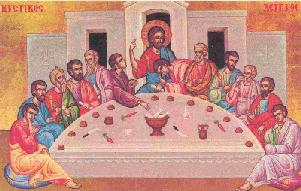Christianity as a Mystery Cult
Christianity's first appearance in the Roman empire would have been as a Mystery Religion like the ones mentioned on this page. As it severed its ties to Judaism by the end of the first century CE, pagan converts were attracted to it and brought with them many of the concepts they knew from mystery religions. Though in comparison to the other Mystery Religions of the time it was by far the most actively persecuted, Christianity eventually became accepted and finnally declared the official religion of the Roman Empire by the Emperor Constantine.
 As
a Mystery Religion, the early Christians adopted symbols and customes from their
contemporaries. The bread wafer of the Eucharist can be traced back to a Mithraic
holy meal where flat bread loaves marked with a cross were eaten. The linking
of the cycle of the life and rebirth of Jesus to the seasons could be seen as
adopting the idea from the Eleusinian Mysteries.
Also (as mentioned before) many of the titles attributed to the Virgin Mary
can be attributed to the Cult of Isis who
used them to refer to their patron goddess.
As
a Mystery Religion, the early Christians adopted symbols and customes from their
contemporaries. The bread wafer of the Eucharist can be traced back to a Mithraic
holy meal where flat bread loaves marked with a cross were eaten. The linking
of the cycle of the life and rebirth of Jesus to the seasons could be seen as
adopting the idea from the Eleusinian Mysteries.
Also (as mentioned before) many of the titles attributed to the Virgin Mary
can be attributed to the Cult of Isis who
used them to refer to their patron goddess.
To the contrast of other Mystery Religions, however, Christians openly preached their "secret knowlege." Their message simply insisted that only through following Christianity was there any hope of salvation after death. This would have been even more surprising in the Empire as well, as this message entailed worship that openly defied the laws of Rome. As reinforcement of this message to the curious Romans, Christian martyrs made open shows of their lack of fear of death. The public executions paradoxically served to raise interest in Christianity. Even so, these persecutions were the primary reason Christians worshiped in secret, and that secrecy is the most important link between Christianity and the Mystery Religions.
The end of Christianity as a Mystery Religion can also be identified as the beginning of it as the dominant religion of the Empire. According to legend, the Emperor Constantine prayed for help in a coming battle, and during his prayer he received a vision of a symbol to place upon the shields of his army. This symbol was supposedly the crucifix, and discoving that the Christian God had helped him succeed he began the integration of Christianity within the Roman Empire. Eventually under later emperors Christianity became the official religion of the Empire.
It should be noted, somewhat ironically, that according to most accounts Constantine himself did not convert to Christianity until on his deathbed: a tradition that would be followed by a great number of fashionable Romans for quite some time into the future.
Sources
Sandara Frankiel, Christianity